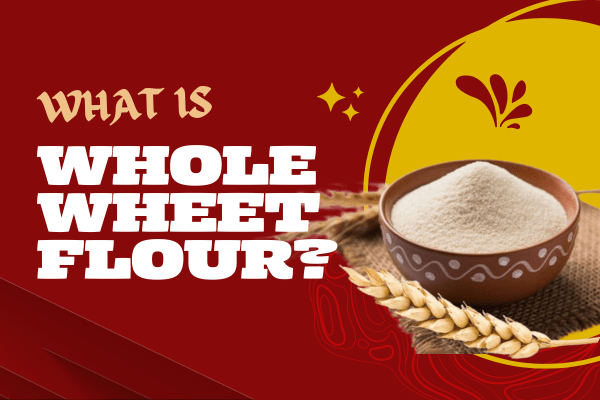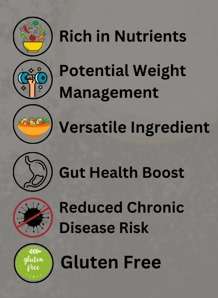Whole Wheat Flour

1.Introduction to Whole Wheat Flour
I.What is Whole Wheat Flour?
Whole wheat flour is a type of flour that is made by grinding the entire wheat kernel, which includes the bran, germ, and endosperm. This comprehensive milling process preserves all the essential nutrients and fiber found in the grain, making whole wheat flour a healthier alternative to refined white flour.
II.The History and Origins of Whole Wheat Flour
The use of whole wheat flour dates back thousands of years. Ancient civilizations, such as the Egyptians and Mesopotamians, were among the first to cultivate wheat and grind it into flour. Throughout history, whole wheat flour has been a staple in many cultures, valued for its nutritional benefits and hearty flavor.

2.Nutritional Benefits of Whole Wheat Flour
I.Why Whole Wheat Flour is Healthier
Whole wheat flour is healthier than white flour because it retains all parts of the wheat grain, including the nutrient-rich bran and germ. This means it contains more fiber, vitamins, and minerals. White flour, on the other hand, undergoes a refining process that removes these beneficial components.
II.Comparing Whole Wheat Flour with White Flour
Whole wheat flour and white flour differ significantly in their nutritional profiles. Whole wheat flour is higher in fiber, protein, and essential nutrients like B vitamins, iron, magnesium, and zinc. White flour, while often enriched with some vitamins and minerals, lacks the fiber and many of the original nutrients found in whole wheat flour.
III.Essential Nutrients Found in Whole Wheat Flour
Whole wheat flour is a rich source of dietary fiber, which aids in digestion and helps maintain healthy blood sugar levels. It also contains important vitamins and minerals, including:
- B vitamins: Essential for energy production and brain function.
- Iron: Crucial for transporting oxygen in the blood.
- Magnesium: Supports muscle and nerve function.
- Zinc: Vital for immune system health.

3.Health Benefits of Whole Wheat Flour
I.Whole Wheat Flour and Digestive Health
The high fiber content in whole wheat flour promotes healthy digestion by adding bulk to the stool and aiding regular bowel movements. This can prevent constipation and support overall digestive health.
II.How Whole Wheat Flour Supports Weight Loss
Whole wheat flour can aid in weight loss by providing a sense of fullness and reducing overall calorie intake. The fiber in whole wheat flour slows down digestion, which helps control hunger and reduces the likelihood of overeating.
III.The Role of Whole Wheat Flour in Diabetes Management
Whole wheat flour has a lower glycemic index compared to white flour, which means it causes a slower rise in blood sugar levels. This makes it a better choice for people with diabetes, as it helps in managing blood sugar levels more effectively
4.Baking with Whole Wheat Flour
I.Tips and Tricks for Baking with Whole Wheat Flour
Baking with whole wheat flour can be a bit different from using white flour, but with the right tips, you can achieve great results:
- Hydration: Whole wheat flour absorbs more liquid, so you may need to add extra water or milk to your recipes.
- Resting Time: Allow your dough to rest longer to let the bran and germ absorb the moisture, resulting in a better texture.
- Mixing Ratios: Start by replacing half of the white flour with whole wheat flour in your recipes to get accustomed to its effects.
II.How to Substitute Whole Wheat Flour in Your Favorite Recipes
When substituting whole wheat flour for white flour in recipes, use the following guidelines:
- Start Small: Replace 25-50% of the white flour with whole wheat flour to start.
- Adjust Liquids: Increase the liquid content slightly to account for whole wheat flour’s higher absorption rate.
- Add Rising Agents: Consider adding a bit more yeast or baking powder to help with leavening.
- Hydration: Whole wheat flour absorbs more liquid, so you may need to add extra water or milk to your recipes.
- Resting Time: Allow your dough to rest longer to let the bran and germ absorb the moisture, resulting in a better texture.
- Mixing Ratios: Start by replacing half of the white flour with whole wheat flour in your recipes to get accustomed to its effects.
III.Common Mistakes to Avoid When Using Whole Wheat Flour
Avoid these common mistakes when baking with whole wheat flour:
- Overmixing: This can lead to dense and tough baked goods. Mix just until combined.
- Ignoring Liquid Adjustments: Failing to add extra liquid can result in dry and crumbly textures.
- Not Resting the Dough: Skipping the resting period can make it harder for the dough to hydrate properly.
5.Whole Wheat Flour Recipes
I.Delicious Recipes Using Whole Wheat Flour
Explore these delicious recipes to incorporate whole wheat flour into your diet:
- Whole Wheat Bread: A nutritious and hearty bread perfect for sandwiches or toast.
- Whole Wheat Pancakes: Fluffy and wholesome pancakes ideal for a healthy breakfast.
Whole Wheat Muffins: Perfect for a snack or breakfast, loaded with fiber and nutrients.
II.Whole Wheat Bread: A Step-by-Step Guide
Making whole wheat bread is simple with this step-by-step guide:
- Mix Ingredients: Combine whole wheat flour, water, yeast, salt, and a touch of honey or sugar.
- Knead Dough: Knead until smooth and elastic.
- First Rise: Let the dough rise in a warm place until it doubles in size.
- Shape and Second Rise: Shape the dough into a loaf and let it rise again.
- Bake: Bake in a preheated oven until golden brown.
III.Healthy Snacks with Whole Wheat Flour
Whole wheat flour is perfect for making healthy snacks such as:
- Whole Wheat Crackers: Crispy and flavorful, great with dips.
- Whole Wheat Banana Bread: Moist and delicious, ideal for a quick snack.
- Whole Wheat Cookies: Nutritious and tasty treats for any time of day.
6.Whole Wheat Flour in Different Cultures
I.Traditional Dishes Made with Whole Wheat Flour Around the World
Whole wheat flour is used in many traditional dishes globally:
- Chapati and Roti (India): Unleavened flatbreads enjoyed with various dishes.
- Pita Bread (Middle East): Soft and versatile, perfect for wraps and sandwiches.
- Whole Wheat Tortillas (Mexico): A healthier version of traditional tortillas.
II.Whole Wheat Flour in Mediterranean Cuisine
In Mediterranean cuisine, whole wheat flour is used to make:
- Whole Wheat Pita Bread: A staple in many Middle Eastern dishes.
- Whole Wheat Pasta: A nutritious alternative to regular pasta.
III.Whole Wheat Flour in Indian Cooking
In Indian cooking, whole wheat flour is essential for making:
- Chapati: A staple flatbread in Indian households.
- Paratha: A layered flatbread often stuffed with various fillings.
- Poori: Deep-fried bread enjoyed with curries.
7.Buying and Storing Whole Wheat Flour
I.How to Choose the Best Whole Wheat Flour
When buying whole wheat flour, consider the following:
- 100% Whole Wheat: Ensure the label states it’s 100% whole wheat.
- Organic Options: Choose organic to avoid pesticides.
- Freshness: Check the expiration date for freshness.
II.Proper Storage Tips for Whole Wheat Flour
To keep whole wheat flour fresh:
- Airtight Containers: Store in airtight containers to prevent moisture and pests.
- Cool, Dark Place: Keep it in a cool, dark place like a pantry.
Refrigeration: For longer shelf life, store in the refrigerator or freezer.
III.Understanding Labels: Whole Wheat Flour vs. Whole Grain Flour
Whole wheat flour is made from the entire wheat kernel, while whole grain flour can be made from various whole grains like barley, oats, or rye. Always read labels to ensure you’re getting the product you want.
8.Sustainability and Whole Wheat Flour
I.The Environmental Benefits of Choosing Whole Wheat Flour
Whole wheat flour is more environmentally friendly because:
- Less Processing: It requires less processing, reducing energy consumption.
- Whole Grains: Supporting whole grain agriculture promotes biodiversity.
II.Supporting Local Farmers by Buying Whole Wheat Flour
Buying whole wheat flour from local farmers supports sustainable agriculture and reduces carbon footprints associated with transportation.
III.The Role of Whole Wheat Flour in Sustainable Eating
Incorporating whole wheat flour into your diet supports sustainable eating habits by promoting the use of less processed, more nutritious foods.
FAQs About Whole Wheat Flour
Frequently Asked Questions About Whole Wheat Flour
Q: Can I use whole wheat flour in any recipe? A: Yes, but you may need to adjust the liquid and rising agents.
Q: Is whole wheat flour gluten-free? A: No, whole wheat flour contains gluten.
Common Myths and Misconceptions About Whole Wheat Flour
Myth: Whole wheat flour is bitter. Fact: It has a nutty flavor, which some may perceive as bitter if not used to it.
Myth: Whole wheat flour is hard to bake with. Fact: With the right tips, it’s easy to bake delicious goods with whole wheat flour.
Expert Answers to Your Whole Wheat Flour Queries
Q: How should I store whole wheat flour? A: Store it in an airtight container in a cool, dark place, or in the refrigerator or freezer for longer shelf life.
Q: Does whole wheat flour expire? A: Yes, it can go rancid due to its oil content, so always check the expiration date and store it properly.
Conclusion
Whole wheat flour is a versatile, nutritious ingredient that offers numerous health benefits and supports sustainable eating practices. By understanding its properties and learning how to use it effectively in your cooking and baking, you can enjoy delicious and wholesome meals. Embrace whole wheat flour in your kitchen and discover the positive impact it can have on your diet and health.

